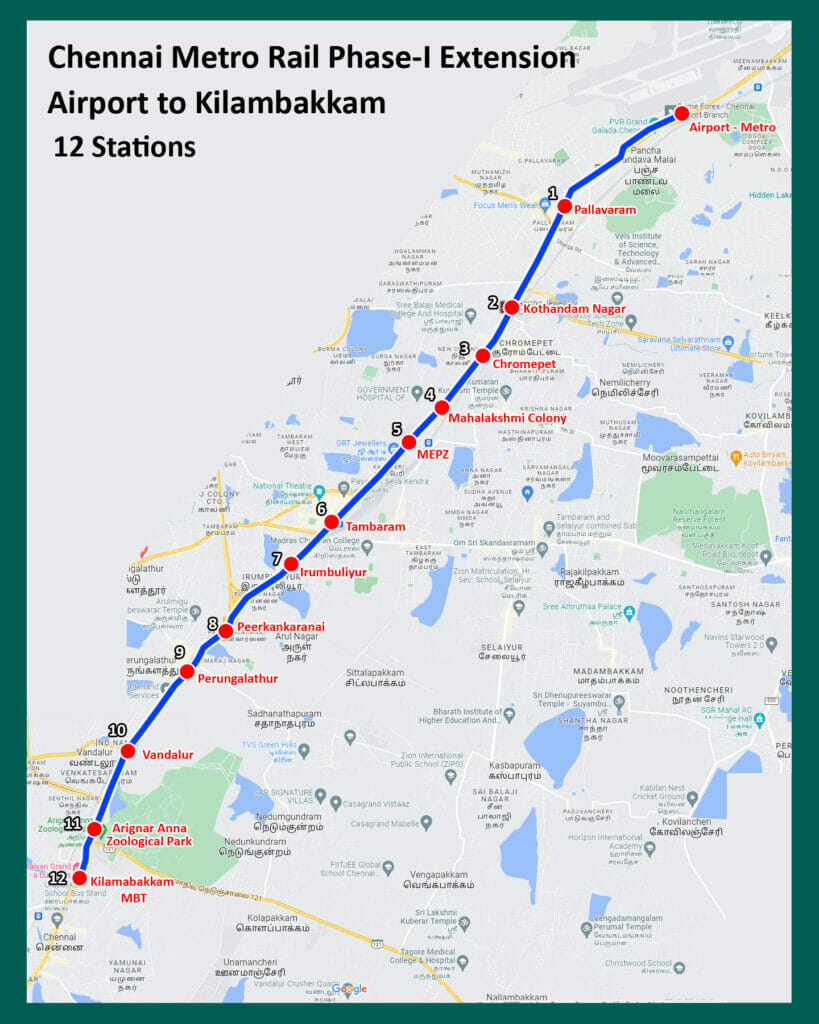Before the arrival of the Chennai Metro, the Metropolitan Transport Corporation (MTC) bus and Electric Multiple Unit (EMU) train services were the primary drivers of public transport, largely defining the local transport landscape for people in Chennai’s core area.
The EMU services ran in three directions North Line, West Line and South Line and helped in residential development as people moved out of the core city, due to the availability of a comfortable reliable transportation system and reduced travel time. The suburban rail network was a boon to commuters from faraway, suburban localities such as Palavanthangal and Tambaram.
But with the passage of time and the growth of the city and its population, there was no room for rail network expansion within the city. This led to a huge deficit in public transportation as the MTC could not handle the demand of such a huge commuting population.
City planners had no option except to opt for a metro rail system, as adopted by many global cities, to fulfil the void in public transportation.
In order to cater to the connectivity needs of the current population and public transportation demand inside Chennai core city and peri-urban areas, the Government of Tamil Nadu has taken the right decision to focus on the expansion of the metro rail network.
This network will connect the city in all directions and provide a speedy link between all destinations for a growing population.
Read more: Chennai Metro: Future of public transport or white elephant?
Advantages of using the Chennai Metro
A quick comparison between using private vehicles and the Chennai Metro shows the cost and time-saving aspects of this mode of transport.
For example, a trip from the Chennai Airport to Government Estate in the Metro would take only 26 minutes with a round trip price of Rs 64. The same trip by car would take an hour and 15 minutes and cost the user around Rs 400. With a two-wheeler, the travel time would be around one hour, but not without the added risk of navigating poor roads and the increasing threat of road accidents.
Usage of the Metro can also help reduce one’s carbon footprint in the age of climate change. Any responsible citizen with concern for the future should look to such an efficient means of public transport to do their bit by opting to shun private vehicle use.
While EMU services have failed to keep up with changing times by not introducing ticketless travel, failing to improve accessibility in stations for the elderly and disabled, or ensuring multimodal transit options, in contrast, the Metro has worked to ensure all of the above. There are also issues with train frequency and increasing travel time that the EMU has failed to address.
The issue of commuter safety, especially that of women’s safety has been neglected in the case of EMU’s poorly lit stations. That and lack of access to washrooms remain unaddressed issues, despite repeated incidents around the same.
Read more: Chennai Metro in figures: How does it compare with Mumbai or Delhi Metro?
Scope for improvement in the Chennai Metro
For those looking to take the metro from the suburban areas, the feeder bus service is a huge welcome among commuters of Pammal, Pallavaram, Hastinapuram, Chitlapakkam and Tambaram residents as it very economical to reach the metro station.
More small buses or tempo travellers can be run within a radius of around 10km within the core city to make last-mile connectivity more accessible to reach the destination.
Running such feeder services from stations to high travel/tourist destinations such as T Nagar, Pondy Bazaar, Marina Beach, Santhome and Purasaiwalkkam would also help ease issues of last-mile connectivity.
More parking spaces, especially for two-wheeler parking, must be added in high-traffic stations. QR code payment should be allowed in parking spaces as well.
As a resident of Tambaram, the Metro extension is a huge welcome among the residents here due to its affordability, ease of commute, accessibility, reduced travel time and safety.
As the population has grown in recent times in areas such as Perungalathur, Tambaram, Chitlapakkam, and Chromepet – away from the core city – the demand for reliable public transport in the area has risen. With many daily commuters looking to public transport to reach schools, colleges and places of work, the Metro will play a crucial role in filling a gap.

The hope of many residents is that the construction of the Airport-Kilambakkam metro line construction will be expedited and completed in the year 2026, to join the 160km integrated comprehensive Metro transportation system of Phase 1 and Phase 2.
With the above done, the connectivity to the core city would improve vastly for those in the suburbs and help mass mobility with low cost and low carbon emissions.
Very nice.Keep writing and keep taking up issues.
Dayanand, I recall reading that CMRL is taking over the MRTS. If this is true, what changes can we expect in MRTS operations? Will this apply to the 3 suburban lines as well?